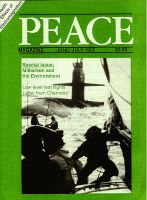
Peace Magazine Jun-Jul 1989, page 27. Some rights reserved.
Search for other articles by M.V. Naidu here
Recently I conducted a survey of peace studies in Canada. First of its kind, the survey was published as a special issue of Peace Research, Vol. 20(3), September, 1988.
My study covers two aspects: one, peace courses being currently offered in Canadian universities; the other, peace articles published in Canadian scholarly journals and popular magazines between 1980-87.
Some of the surprising findings of the survey are the following: Out of thousands of courses being offered by 46 of the Canadian universities, only 163 courses could be considered relevant to peace, either directly or indirectly. In the whole of Canada there are only 22 peace courses offered at the graduate level. While there are a number of strategic studies or defence studies programs and centres on Canadian campuses, there is not a single peace studies centre as part of a university.[Ed. note: McMaster University's centre has recently been approved.]
Out of 47 Canadian scholarly journals (English) listed in the Canadian Periodical Index, 33 of the journals did not publish during 1980-87 a single piece on any peace theme; and the remaining 14 journals published, on an average, 0.67 peace articles per journal per annum, while Peace Research, the only journal of its kind, averaged 14.63 articles per annum.
Of the 57 popular magazines that are relevant to peace discussion, 24 did not publish any peace articles during 1980-87; 32 of the magazines averaged 0.9 articles per magazine per annum. One publication, Peace Magazine, published 46 articles during one year.
Supplemental to the survey, I wrote an article, "SSHRCC and Peace Studies," that was published in the January 1989 issue of Peace Research. It analyzes the 1987-88 Annual Report of Social Sciences and Humanities Research Council of Canada (SSHRCC) from the point of view of peace studies in Canada. The analysis shows that out of the $64 million dollars that SSHRCC spent during 1987-88 on grants for research, conferences, publications, and the like, peace studies (in its broadest sense) received only $300,000.
While the Canadian Peace Research and Education Association (CPREA), the only scholarly association of its kind, was denied a $2,000 annual grant and the CPREA organ, a journal called Peace Research, was not considered worthy of a $3000 subsidy, SSHRCC gave out $882,568 to 76 other associations and another $1.9 million to 149 journals. Included among the associations that were considered worthy of support were the Society for Mesopotamia Studies ($3,834) and the Canadian Society for the Study of Names ($2,662). SSHRCC also funded conferences -- e.g. "pilgrimage in the Middle Ages" ($6,750) -- and to such research projects as "Chinese burial practice" ($8,325), archaeological excavations at ancient Mytilene in Greece ($108,525), "Widows and widowers in early nineteenth-century Montréal," ($51,317), "English mothers and the guardianship of children 1500-1800," ($65,122), and so on. Besides, SSHRCC subsidized the publication of 146 books to the tune of one million dollars. Some titles published were The Nature of Early Greek Lyric; Cults of Boetia; and Canadian Football. Only three out of 146 titles could be called peace books.
My article on SSHRCC contends that most of the Canadian academics prefer to research and write on archaic, irrelevant, conservative, and non-controversial subjects, and that there is considerable antipathy toward peace studies among Canadian academics and administrators.
Please participate in publicizing this issue and raising academic awareness and public debate.
M.V. Naidu is Professor of Political Science, Brandon University.

Peace Magazine Jun-Jul 1989, page 27. Some rights reserved.
Search for other articles by M.V. Naidu here